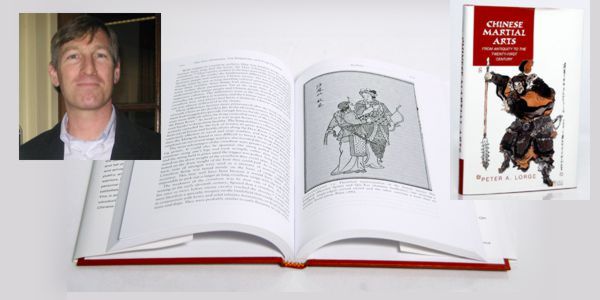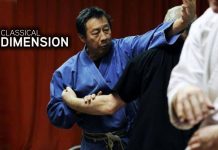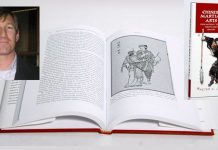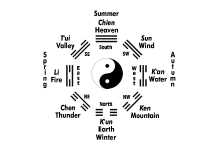Peter Lorge on Chinese Martial Arts: From Antiquity to the 21st Century Part 2
In the beginning of 2012, Peter Lorge, an Assistant Professor of History at Vanderbilt University, published a new scholarly work, Chinese Martial Arts: From Antiquity to the Twenty-First Century, through Cambridge University Press. This ambitious and unprecedented book examines the history of Chinese Martial Arts by dynasty, beginning with the Peter Lorge. Lorge’s book presents many challenges to several generally accepted notions about Chinese martial arts that will fuel debates on both sides of contemporary martial issues.
It is a remarkable contribution to the field, a required read for any serious student of the martial arts.
We had the opportunity to interview Peter Lorge on February 3, 2012.
GC: What inspired you to take on this book?
PL: It’s funny. It’s the book that I wanted to read when I was in high school. I basically spend my time now writing the books that I wished I could have read when I was in high school – 25, oh maybe 30 years ago.
GC: What is your personal martial arts background?
PL: I started with a guy named Lou Neglia, Sensei Lou Neglia, back in Brooklyn, who was doing what we would now call mixed martial arts back then. It was based around full-contact kickboxing, but it was joint locks and throws. It really stressed practical street fighting. That was his really big thing. And that was why I was taking it at that time. I was a nerdy book-reading kid in Brooklyn – scrawny – looking for a little self-defense, a little toughening up. And it was a really tough school. It was ideal in that sense for me. I was there for a couple of years, then I went to college. In college I took shuai jiao – Chinese wrestling – for a bit, and then kendo for a year. And then I ended up in taekwondo for – I guess it was like three years. That’s where I got my first black belt – well, my only black belt in anything. And after I graduated and went to graduate school, I first, when I was in England, I was studying kenjitsu with an aikido guy. He was teaching kenjitsu as a way of teaching aikido. And then there was some other hybrid Korean art – it was one of those things where some Korean master wasn’t getting to be one of the chief persons in some other Korean organization so he started his own organization. But I never actually met the master there. And then I came back to New York and studied with Jack Schamburger who does this Chinese Hawaiian kenpo. And then I went to Philadelphia for my PhD and studied with some taekwondo guys for a while. I studied some more kenjitsu – Niten Ichi Ryu swordsmanship with Peter Hobart. Then I was in Taiwan and I did more taekwondo. That was when I was working on my dissertation. Then I came back to the U.S. and my wife and I went to China for her research. While in Beijing, I was studying taiji Yang style sword. And that brings us to getting back to the U.S. The last couple of years I’ve been doing Brazilian Jiu-jitsu under Shawn Hammonds. I think that’s most of it. I might have missed something.
GC: Surprisingly little Chinese styles.
PL: Yeah. There aren’t a lot of Chinese style martial arts around. I’m quite curious about this. In the U.S., the most consistently available Chinese art tends to be taiji. And then, I’ve been told there’s some guy who does Wing Chun on Vanderbilt campus who is very good and fairly exclusive. I’m going to try and track him down. There’s just not that much Chinese stuff. Of course, I’m in Nashville now, which is a smaller market. I’m sure if I was in New York or California there’d be more.
I’ve gone with what’s available and have been fortunate to have had quite a large percentage of very good teachers. I would counsel people to go with the teacher over the style because a good teacher is where it’s at.
Now I would like to do more. I’m very curious about Wing Chun. There was some of it in my first teacher’s street-fighting stuff. The other thing is I’m getting older. If there’s any practicality to what I do, I’m going to need to convert to things that require a lot less brute force and toughness.
GC: Until recently, scholars have largely overlooked the Chinese martial arts. Why do you think that is?
PL: Well, Chinese studies is a very small field. Until not that long ago, we didn’t even talk about Chinese military history. That’s really my main field – Chinese military history. So consequently, imagine if you took a random scattering of academics, and you said, “Well, what are you interested in?” And they all just did what they were interested in. And that’s how the field kind of grew up. You had these who did Neo-Confucianism – there’s a lot of them. I was trained in social and economic history because that’s what my teacher did.
For martial arts, there just hasn’t been that many. There has been a certain reluctance to talk about Chinese martial arts as actually martial, which was one of the other main points in my book. This really is about violence. I have gotten all kinds of resistance from people. When I was taking taiji in China, and an American taiji student said to me, “Well, do you really think taiji is a martial art?” Fortunately, just that morning my teacher had yelled at me that it’s a sword, not a stick. The point is, I got a sword in my hand here. And I have to treat it as a sword and not a stick. So it really is martial. But the number of people in Chinese studies had just kind of a reflexive reaction away from anything martial. People don’t go into Chinese studies because they’re interested in martial things. If you’re interested in that, you go to Japan because they’ve got the Samurai. In China, that just hasn’t been the case, even though everyone is watching the movies, right?
GC: Right.
PL: I’m hoping to do in the future – because I also do film studies stuff – I’m thinking of doing a film study book in the future on reading martial arts into movies. I would end up in these conversations over the years with all kinds of people in Chinese studies who would say something and I would say, “Well, actually, this is what is going on.” And they would say, “Really? You can know that?” Well, yeah, you can know that. Donnie Yen is saying that in IRON MONKEY they’re doing Hung Gar. It’s kind of old-fashioned but he’s trying to be old fashioned for the character, so he’s choosing a particular martial art for a scene and there’s a narrative in the way people fight. And you can read that. There’s a meaning to it.
I did a paper some years ago at the Buffy the Vampire Slayer conference, if you can believe that.
GC: I never knew there was such a thing.
PL: They had it in Nashville, so I convinced another academic friend of mine who was also into Buffy, and we both went. I did one that was “The Martial is the Message: Why Buffy Can’t Fight.” It’s all about how she keeps becoming more and more powerful and accomplished but she isn’t getting any better at fighting. And the reason why is because the point of the fight is not for her to just beat someone up, but to show whatever her emotional state. What do we want in a movie? We don’t want someone who’s so good that they just come in and beat everyone and there’s no challenge. It’s a question of character. And you can look at all these movies and see these things.
But I think what happens in the field – to get back to your actual question rather than rambling off – people began to study certain areas and a lot of those areas came out of what in a lot of cases were being studied in China or Japan, because that’s where people went to learn. We all do that. And then after a while, when something wasn’t studied, someone would say, “Well, what about this?” And someone would assume that because there’s no study on it, there’s nothing there to find. So it becomes self-reinforcing over time. And what I’ve found from most of the academics that I meet, they’re shocked to find that there’s actually considerable materials on martial arts history. I think in my period – from the tenth to the thirteenth centuries – I’m figuring there’s easily three or four books worth of material there. And of course, we can find it now very easily because everything is on computer and you can just search for things. In the past, people just assumed that if it hasn’t shown up, it’s because it can’t be done, so I guess it can’t be done. The reason why it’s done in Japan – we have these studies and we have information – is that it was more important to them. So they have the records and they exist, rather than where we are in China. “Oh, we don’t have it.” And it turns out, of course, we have tons and tons and tons of the stuff, particularly the later you go. You get into the Ming Dynasty and the Qing Dynasty and it’s more than anyone could really get their hands around.
I’m very hopeful – having written this book – that now other academics will begin to generate academic studies and find out. Maybe even do nice things like invite me for nice honorariums to come speak. That’s my goal (laughs).
GC: To change gears a bit, I really enjoyed your section on “Authenticity and Real Kung Fu.”
PL: Oh, I’m giving a paper on that next week at Berkeley.
GC: You’re going to be at Berkeley? We’re based really close to Berkeley.
PL: Oh. It’s on Friday next week. It’s a paper called, “Will the Real Kung Fu Please Stand Up? Authenticity in the History of Chinese Martial Arts.” [NOTE: For coverage of this talk, see the May June 2012 issue of Kung Fu Tai Chi]
GC: Maybe I should just go to that and I’ll get the answer to my next question, but for the sake of this interview, when someone asks you, “Is my kung fu real?” how do you respond to that?
PL: Well, do you know Stan Henning?
GC: Only professionally.
PL: Stan was sort of persona non grata in the taiji community, I understand, for a while for telling them that the legendary stuff is really just legendary. I’m with the Brazilian Jiu Jitsu guys and mixed martial arts guys and authenticity isn’t an issue for them because they’re not looking for tradition. The guys I roll with, they compete internationally. So from their perspective it- Okay, here’s this person, he won in international competition or he’s a top guy. You don’t need anything more in the way of authenticity. But I have had more people tell me like, “You know, I’m doing this.” Wing Chun is a really ripe one; it’s just all legend. You’ll see on a website; they’ll talk about this woman and this whole thing. It doesn’t make people happy if they ask me and I tell them that the martial arts are really martial.
Ultimately the question is, why do you care whether it’s authentic? The problem is, it depends on why you’re doing it. If you’re doing it for health reasons and it makes you feel better – I do jiu jitsu mostly for health. It keeps me as a middle-aged man in good shape because I roll with twenty-year-olds who are stronger and faster and all that stuff. So I have to work hard for that. I don’t work as hard if I’m going to lift weights. But I’m not there to learn how to defend myself. I presume it has some function in those respects. If you’re looking for self-defense, the only reason you’re looking for authenticity is the presumption that if something is authentic, then it must be more effective because it has been around for a long time. And if that’s why you’re looking for authenticity, I can see a certain logic to that because if you’re like me and don’t actually expect to ever be in a fight. But on some level you want some self-defense capability. Well, you’re doing it very much in the abstract. You may never find out if it’s effective if you’re lucky. But how do you know whether it’s effective? Authenticity becomes a substitute for that.
Now if you’re looking for something that, like what I once referred to as a somatic – in the sense of the body. I’m not Chinese and I want to experience physically what it is to be doing something Chinese, like authentically Chinese, because my goal is, I want to experience physically what it is to be doing something Chinese. Or I’m Chinese-American or I’m Chinese and I want to do something authentically Chinese to make myself feel like I’m doing something Chinese, that becomes very problematic because we can’t really tell you whether the forms that we’re doing now, how similar they are to what was done in the past. People in the field of dance have the same problem.
Another area that I’ve been starting to do some work is Chinese food. You have problems of what is authentically Chinese food. I told a student yesterday – he was shocked; he was from Sichuan – I said, “You know, the chili pepper isn’t native to China.”
GC: I thought that was a brilliant point in your book.
PL: It’s a New World crop. You watch someone try to register this notion from Sichuan that there weren’t chili peppers in China before the Europeans brought them over from the New World. He couldn’t (laughs). If you think about what your image of the world is and the food is not what you imagine it to be, it’s really a disruptive concept.
It always happens when you are in the role of expert. When someone asks you a question, they want you to confirm what they already believe and maybe elaborate on it. They get very upset with you when you don’t. When you say, “Well actually, no,” and “This may not be the case, but why are you worried about that?” I think it’s really hard. I’ve been very fortunate in having good martial arts teachers but we’ve all experienced going somewhere and having someone show us some form and you say, “Wow, their stance is horrible. Why did their teacher let them get away with that? My teacher would have never let me get away with that and I’m not even good.” What’s the defense for that? Is this guy going to say, “My teacher is authentically so-and-so.” The Shaolin stuff is classic in that. There’s a great line from the Wutang Clan – it blows my mind that they call themselves that – who all practice Shaolin martial arts, my understanding is. He was saying some comment about this kung fu these people were doing was not the real Shaolin kung fu. All I could think of as an academic is, it’s so wrong on so many levels, every single thing that he just said. You can’t even begin to explain what your assumption is and where that’s coming from.
But you point to a very important point which is, this conference that I’m going to, is actually on the question of authenticity because authenticity is an enormous problem for precisely the reason that you point out. What’s my authentic martial art? I don’t know. I want to do something authentic. I want to eat something authentic. I want to go to another country and have an authentic experience. I don’t want to be a tourist. You know, I’m from New York, and somehow for someone to be a tourist is inauthentic as opposed to someone who lives there who is authentically of the place. Unfortunately again, the academic makes it into a tremendous intellectual question and bores the hell out of everybody else.
GC: Well, to change gears again, you give a lot of attention to the history of women in Chinese martial arts. Why was this important to you?
PL: What’s really interesting looking at films and how Chinese martial arts films, not Japanese martial arts films – Japanese films didn’t have this effect – Chinese martial arts films moved into the Hollywood consciousness the ability of women to fight. Somehow, in the Chinese discourse – and it shows up in the Chinese novels (these female martial artists, and they’re effective and they’re important) – somehow there is a different perspective in China about what training and fighting can do. In China, training and fighting can make a woman an effective warrior. At the same time, armies are highly gendered institutions. There are no more women in Chinese wars than in wars anywhere else. Somehow, Chinese martial arts allow women to fight men, and that’s a different cultural strand that’s very important to me because when I look at how things are now, I want to draw the line back there.
So that’s one level. The second level is that I wanted to make the book about the place of martial arts in society, not just here it is. In terms of that, I was looking for some kind of topic particularly to begin with that would cause the reader to examine their own attitudes, or at least to look at this notion of where martial arts fit in Chinese society, to bring up an example that would cause them to say, “Oh, that’s different.” It’s not exactly what they expect.
Then, of course, you have the issue that the first person I start with, Fu Hao or Lady Hao, is a really important archeological find, so that’s very useful. The other thing is that I’ve done a bunch of this stuff myself. There’s a bandit that I haven’t written on in a while. His wife is a very important martial figure. And I did an article on portrayals of middle ages in film. And I did it on the movie A TOUCH OF ZEN and how you have this female character in there and all the different Chinese roles in society that she takes over the course of the film, in order on one hand to satisfy Confucian norms and on another Buddhist norms and then to be a martial artist. And then there’s all this fighting that goes on.
Also in the history profession, we’ve been working really hard for a long time to include everybody when we talk about history. So I was very conscious of the fact that I was writing a book that, I hope, is going to be the beginning of many books by other people coming out. And if we’re going to start talking about the martial arts from the beginning, we need to talk about everyone. Did women do this? If they did, why? How? Who? The steppe women did martial arts. They were archers and swordsmen. In China, there were very specific groups that did it. And so my thought there was I’m trying to get it right, at the beginning, rather than just ignoring that.
And the ultimate final reason is, I have two daughters, and I have my oldest in martial arts. So I’m very conscious of that on just a personal level.
For part 2 of Peter Lorge on Chinese Martial Arts: From Antiquity to the Twenty-First Century; Click Here.
Written by Gene Ching for KUNGFUMAGAZINE.COM
© COPYRIGHT KUNGFUMAGAZINE.COM, ALL RIGHTS RESERVED.
All other uses contact us at gene@kungfumagazine.com











